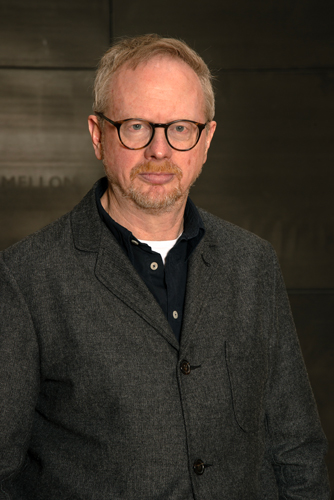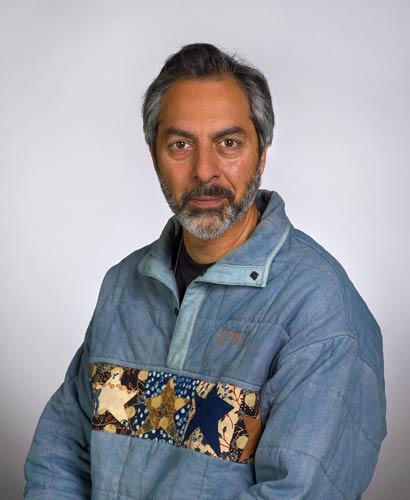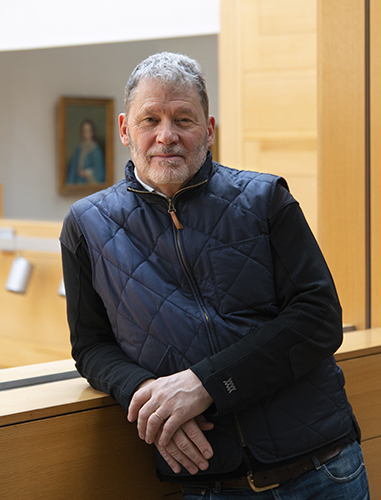Awardees | 2024
Tobah Aukland-Peck
 Tobah is a PhD candidate in art history at the CUNY Graduate Center. While at the YCBA she will be working on her dissertation, “Mineral Landscapes: British Art and Extraction, 1937–1975.” Her dissertation demonstrates that mid-century British artists, including Bill Brandt, Prunella Clough, Peter Lanyon, John Latham, and Graham Sutherland, placed extractive themes— infrastructure, material, and miners—at the center of experiments in abstract and conceptual art. The mine was dark, unfamiliar, and densely material, attributes that challenged vision and thus realism. Artists adopted the mine’s visual limitations to create nonrepresentational artworks that integrated themes of class, environment, and labor. Though earlier figural projects explicitly pictured the social and environmental impact of extraction, these mid-century artworks elevated its representation beyond the human body. Her chapters center around material—coal, fossils, oil, tin, and waste—and trace the arc of British mining from vital industry to obsolescence. This approach, both material and chronological, rethinks the progression of mid-century British art through problems of industry and pollution.
Tobah is a PhD candidate in art history at the CUNY Graduate Center. While at the YCBA she will be working on her dissertation, “Mineral Landscapes: British Art and Extraction, 1937–1975.” Her dissertation demonstrates that mid-century British artists, including Bill Brandt, Prunella Clough, Peter Lanyon, John Latham, and Graham Sutherland, placed extractive themes— infrastructure, material, and miners—at the center of experiments in abstract and conceptual art. The mine was dark, unfamiliar, and densely material, attributes that challenged vision and thus realism. Artists adopted the mine’s visual limitations to create nonrepresentational artworks that integrated themes of class, environment, and labor. Though earlier figural projects explicitly pictured the social and environmental impact of extraction, these mid-century artworks elevated its representation beyond the human body. Her chapters center around material—coal, fossils, oil, tin, and waste—and trace the arc of British mining from vital industry to obsolescence. This approach, both material and chronological, rethinks the progression of mid-century British art through problems of industry and pollution.
Mia Bagneris
Considering works like John Bell’s Octoroon (1868) and Robert Gavi’s Quadroon Girl (1872), Imagining the Oriental South: The Enslaved Mixed-Race Beauty in British Art and Culture, ca. 1865–1900 explores Victorian Britain’s fascination with beautiful mixed-race women enslaved in the United States. The appeal of such figures persisted even after the abolition of US slavery in 1865 rendered their abolitionist utility obsolete. Tracing this phenomenon, Bagneris’s book analyzes how constructions of race and gender intersected with the politics of colonialism, empire, and slavery and observes resonances between representations of these figures and concurrent expressions of Orientalism. Compared to the upright respectability of Victorian Britain, the US South—especially Catholic Louisiana, the setting for most of these works—could be envisioned as a place of luxury, debauchery, and desire, a perfect echo to the “Orient” amplified by the association of both regions with racially “exotic” women and sexual slavery.
Dominic Bate
Dominic’s project focuses on the art and ideas of the English draftsman Giles Hussey (1710–1788), who tried to set aesthetics on a firm mathematical footing that mirrored the harmony he saw in the universe. The YCBA has the single largest collection of Hussey’s drawings outside the UK, most of which were once owned by the American-born painter Benjamin West, who purchased them at auction in 1785 as “specimens of extraordinary excellence.” As the provenance of the YCBA’s drawings indicates, Hussey was considered a consequential figure in his lifetime; yet today he is virtually unknown. Dominic will use his time at the YCBA to investigate why that is, and to consider how the historical recovery of this artist might alter our understanding of British art in the late eighteenth century.
Jordan Bear
Jordan Bear is associate professor of art history at the University of Toronto. At the YCBA, Bear worked on a project related to William Henry Fox Talbot and his claim that photography had the properties of a natural magic that might fix an image “forever in the position which it seemed only destined for a single instant to occupy.” Paradoxically, the images that offered a viable laboratory for these essays in instantaneity were photographs of workers simulating labor while remaining perfectly still. Calvert Jones, an early photographer, explored this paradox both in his photographs and in a large album of sketches of dockworkers, now held at the Yale Center for British Art. These simultaneous forays in two media suggest that photography’s long exposure time, and the consequent difficulty of capturing motion, were only part of the challenge to depicting labor. This technological limitation was inextricably bound to contemporary anxieties about work stoppages, particularly those resulting from the perceived threat of the obsolescence of the laborer at the hands of machinery, not least the camera itself.
Susanna Collinson
Susanna Collinson is a PhD candidate at the University of California Santa Cruz. Her project focused on the artist George French Angas's extensive travels in South Australia with Governor George Grey and in Aotearoa New Zealand through missionary networks. The resulting folios included what Angas called “implements and domestic economy”: images including fishhooks, calabashes, and woven baskets. In the mid-nineteenth century the term “domestic economy” was seeded through the English-speaking world by homemakers and educators such as Catharine Beecher. Through Angas, I will consider how colonial visual cultures in Australia and Aotearoa New Zealand in the nineteenth century explored ideas about economy, homemaking, and the changing boundaries of the “domestic” sphere. How did gender and household economics influence colonial depictions of Indigenous peoples and their ways of living? Conversely, did the growing body of colonial information from places like South Australia and Aotearoa New Zealand affect how women in the British Empire conceptualized “home”?
Brian Cowan

Brian Cowan is associate professor of history at McGill University. During his time at the YCBA, Brian will study several extra-illustrated texts relating to historical and biographical writing of the long eighteenth century in Britain (1660–1850). He will examine the practice of extra-illustration as a means of understanding the varieties of British historical imagination in the long eighteenth century. Questions he will investigate include: What can extra-illustration tell us about how the past was understood by eighteenth-century collectors and readers of these texts? How does this practice differ from those of readers of other (unillustrated) historical works? What kinds of histories were deemed worthy of extra-illustration? Brian’s project will explore the relationships between political history, secret history, and biography as these genres developed over the course of the long eighteenth century in Britain.
Mark Crinson
 Mark is emeritus professor of architectural history at Birkbeck, University of London. Among many other honors for his work on British architectural history, he was elected Fellow of the British Academy in 2023, and he recently received the Historians of British Art award for a single-authored book with a subject between 1800 and 1960 for Shock City: Image and Architecture in Industrial Manchester (Paul Mellon Centre / Yale University Press, 2022).
Mark is emeritus professor of architectural history at Birkbeck, University of London. Among many other honors for his work on British architectural history, he was elected Fellow of the British Academy in 2023, and he recently received the Historians of British Art award for a single-authored book with a subject between 1800 and 1960 for Shock City: Image and Architecture in Industrial Manchester (Paul Mellon Centre / Yale University Press, 2022).
While at the YCBA, Mark is working on a project titled “Flatlands.” It examines the claimed cultural insignificance of a particular area of flat landscape to the west of London as well its relation to the theme of flatlands in general. Part of a larger book-length project on Heathrow Airport and its surrounding environment, the research supplies a prehistory of evaluations and representations of the area, asking if this supposed cultural insignificance played a role in the environmental despoliations associated with the airport and its surroundings, both deemed subordinate to London’s global city status and the advantages of international connectedness. Now a rump of its former self, a municipal park of barely 200 acres, Hounslow Heath before the nineteenth century was a vast area of “wasteland” 5000 acres in extent. The research looks at the relatively late enclosure of the heath, its landscape characteristics, certain geometric impositions on it (mapping and the military), myths of delinquency and criminality (highwaymen) associated with it, its negative relation to contemporary discourses of the English garden and to the villa culture on its southeastern fringe, and even the very occasional painting of it. The focus is on a varied body of material in the YCBA collections that depicts and describes the area in the eighteenth and nineteenth centuries.
Shezad Dawood
 Shezad is a multidisciplinary artist who interweaves stories, realities, and symbolism to create richly layered artworks, spanning digital media, film, painting, sculpture, and textiles. He trained at Central Saint Martins and the Royal College of Art before undertaking a PhD at Leeds Metropolitan University. He is a research fellow in experimental media at the University of Westminster. Fascinated by ecologies and architecture, Shezad takes a philosophical approach in his work, asking questions and exploring alternative futures through what he calls “world building” and “imagineering.” His practice is animated by research and by collaboration with multiple audiences and communities to delve into embodiment, history, and narrative. His work is held in collections including the British Museum, the Guggenheim Museum, LACMA, the National Gallery of Canada, and Tate. His current exhibitions include Coral Alchemy (Acropora Grove), Manar Abu Dhabi; Guest Relations, Jameel Arts Centre, Dubai; Leviathan, Salisbury Cathedral; and Night in the Garden of Love: Inspired by and Featuring Yusef Lateef, Aga Khan Museum, Toronto, and WIELS, Brussels.
Shezad is a multidisciplinary artist who interweaves stories, realities, and symbolism to create richly layered artworks, spanning digital media, film, painting, sculpture, and textiles. He trained at Central Saint Martins and the Royal College of Art before undertaking a PhD at Leeds Metropolitan University. He is a research fellow in experimental media at the University of Westminster. Fascinated by ecologies and architecture, Shezad takes a philosophical approach in his work, asking questions and exploring alternative futures through what he calls “world building” and “imagineering.” His practice is animated by research and by collaboration with multiple audiences and communities to delve into embodiment, history, and narrative. His work is held in collections including the British Museum, the Guggenheim Museum, LACMA, the National Gallery of Canada, and Tate. His current exhibitions include Coral Alchemy (Acropora Grove), Manar Abu Dhabi; Guest Relations, Jameel Arts Centre, Dubai; Leviathan, Salisbury Cathedral; and Night in the Garden of Love: Inspired by and Featuring Yusef Lateef, Aga Khan Museum, Toronto, and WIELS, Brussels.
Fionn Montell-Boyd
Fionn Montell-Boyd is a DPhil candidate in the department of the history of art at the University of Oxford. While at the YCBA, she will be working on her thesis, “Articles of Silver: The Material and Industry of Photography’s Emergence in Britain, 1780–1841.” During the end of the eighteenth and first half of the nineteenth century, a number of individuals in Britain experimented with using silver halide preparations to make images with light. William Henry Fox Talbot, who announced "the art of photogenic drawing" in 1839, was aware of the fact that these photosensitive materials had made his idea practicable. The availability of silver as a chemical commodity hinged on a colonial trade by which it was mined in Central and South America and shipped across the globe as a raw material and a medium of exchange. Through this metal, early photographic work was tied into different sectors of industry in Britain. Re-examining the emergence of photography through a study of the trade in silver foregrounds forms of labor implicated in the medium, which have been occluded within the standard narrative, allows us to look again at the photographs themselves in terms of the invisible networks that shaped them.
Catriona Murray

Catriona Murray is a senior lecturer in early modern visual and material cultures at the University of Edinburgh. She will be working on a project titled “Figuring Stuart Monarchy: Monumental Sculpture and the Royal Image, 1603–1819.” In Britain, the power of public sculpture was first fully realized and then resisted under the Stuart dynasty. Statues were erected in strategically selected locations, visually articulating the reach of royal power. However, they also became sites for public interventions, which supported and contested Stuart government. This project offers the first in-depth analysis of the development of public sculpture as a political agent in early modern Britain. Examining contests over the creation, destruction, and restoration of Stuart sculpture, it explores how monuments mediated state authority, public loyalty, and opposition. Current debates around the memorialization of Edward Colston, Henry Dundas, and Cecil Rhodes demonstrate that monumental meanings remain vulnerable to resistance. Catriona’s work assesses long-standing issues surrounding the display of public sculpture at a critical historical juncture and will shift understanding of the politics of monumental commemoration.
Michael Prokopow
 Michael Prokopow is an associate professor in the department of history and visual culture, OCAD University, Toronto. Michael returns to the YCBA to continue his research into the museum’s collection of paintings by Arthur Devis. Michael’s interrogation of Devis’s careful presentation of sitters, interior architecture, and objects is part of his broader research into racial capitalism, material gentility, and visual representations of imperial culture. It builds on existing decolonizing readings of eighteenth-century British group portraiture and the interrogation of aristocratic domesticity to reveal inextricable relationships between the economic systems of colonialism, the global circulation of goods, and the enslavement of African and African diasporic peoples. The project also considers the curatorial histories and strategies of the display of Devis's images, with a goal of developing and advancing a decolonizing museology focused on interpretive didactics and institutional labels.
Michael Prokopow is an associate professor in the department of history and visual culture, OCAD University, Toronto. Michael returns to the YCBA to continue his research into the museum’s collection of paintings by Arthur Devis. Michael’s interrogation of Devis’s careful presentation of sitters, interior architecture, and objects is part of his broader research into racial capitalism, material gentility, and visual representations of imperial culture. It builds on existing decolonizing readings of eighteenth-century British group portraiture and the interrogation of aristocratic domesticity to reveal inextricable relationships between the economic systems of colonialism, the global circulation of goods, and the enslavement of African and African diasporic peoples. The project also considers the curatorial histories and strategies of the display of Devis's images, with a goal of developing and advancing a decolonizing museology focused on interpretive didactics and institutional labels.
Jennifer Sarathy
Jennifer is a PhD candidate in art history at the CUNY Graduate Center. Her dissertation, “Art and the Land: Expanded Cartographies of Postcolonial British Art,” examines art in urban and rural landscapes in the United Kingdom in the 1960s and 1970s. It develops a counternarrative of postwar British art, placing artworks that mapped and remapped space by artists like Ian Hamilton Finlay, Susan Hiller, Richard Long, Stephen Willats, and Marie Yates in dialogue with works by Black British artists from the postwar diaspora, including Rasheed Araeen, Frank Bowling, Felipe Ehrenberg, David Medalla, and Aubrey Williams. These diverse artists are analyzed in relation to an increasingly contentious postcolonial national landscape, drawing parallels between representations of space and charged debates over borders, citizenship, and belonging at the time.
Lindsay Wells
Lindsay Wells completed her PhD in art history at the University of Wisconsin, Madison, in 2021 and was most recently a Getty Research Institute–National Endowment for the Humanities Postdoctoral Fellow at the Getty Research Institute. During her time at the YCBA, Lindsay will research a new chapter of her current book project, Evergreen Empire: Plants, Power, and Race in Pre-Raphaelite and Aesthetic Art. This study argues that botanical motifs are essential to understanding how two nineteenth-century art movements evolved in tandem with British imperialism. Thousands of new plants entered British gardens from abroad during this period. The book recovers how the imperialist and racialized rhetoric surrounding these introductions found vivid expression in Pre-Raphaelite and Aesthetic art. During the award period, Lindsay will conduct research for the fourth chapter, which examines narratives about whiteness embedded in the floral imagery of Aesthetic visual culture. Interdisciplinary in its scope, the book will demonstrate how the plants in Pre-Raphaelite and Aesthetic art conceal beneath their leaves the entwined history of imperial plant hunting, Victorian horticulture, and British painting.
Return to the Residential awards page. Return to the Current and past awardees page.